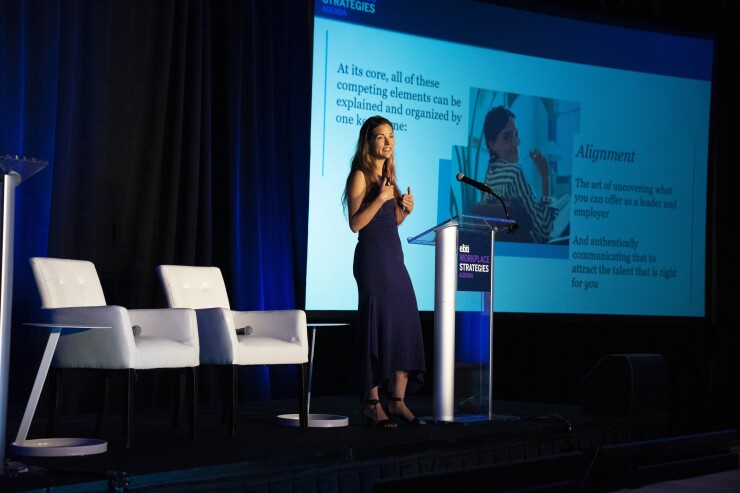Kathryn Minshew always wanted to dye her hair pink.
But as the CEO of The Muse — a company she founded more than a decade ago to help workers find their best career paths and opportunities — she felt like pink hair was a risk she just couldn’t take.
“I said to myself, you run a company that’s all about professionalism. You can’t afford to not be taken seriously.”
But giving the keynote speech at EBN’s Workplace Strategies Conference in Austin, Texas, this week, Minshew was proudly sporting pink hair — and that’s indicative of valuable shifts she’s seen in the workplace through the course of the pandemic.
“Companies are collections of humans, at the end of the day,” Minshew said. “Leading from a place of authenticity and celebrating the diversity of our teams, and acknowledging who we are and who we are not, we’ll be more successful.”
Read more:

Minshew shared her best practices for getting organizations on a path toward what she calls the “art of alignment.” As businesses across industries continue to grapple with a shifting talent market amid the
Jobs, she explained, are no longer exclusively about compensation for workers. It’s about available benefits, inclusive policies, type of
Minshew proposed a four-step method to help businesses understand who they are and what they represent, and how they can
Step one, she explained, is to simply listen — combine in-person and anonymous queries to better understand what your employees are experiencing within your organization. From asking about the best attributions of the company to what could improve, it’s vital to give people the space and freedom to provide feedback.
“If you give people a chance to share the positive, they’re more likely to be honest about the negative as well,” she said. “Pay attention to different groups, demographics and communities to capture diverse voices.”
Step two, she explained, is to plan — chart the organization’s course to its ideal destination — followed by the necessary third step of communicating with team members. Be specific about your company’s strengths, and explain the steps you’re planning to take to mitigate weaknesses.
Read more:
“People are more understanding of coming with you on the journey if they’re aware of where you’re trying to go,” Minshew said.
The final step, she said, is to keep iterating. Taking stock of your company’s culture and how it’s viewed by employees and potential employees can’t be a one-and-done effort. Every six to 18 months, Minshew suggests capturing a fresh pulse on goals and employee sentiment.
As the idea of a one-size-fits-all workplace fails to exist or resonate with today’s workforce, this will help organizations better understand and reach their target employee base, and provide a professional experience that will keep them content in the long-term.
“I prefer the term the Great Reshuffle to the Great Resignation, because most of us are still working and employed, just somewhere else,” Minshew said. “In many cases, what those [workers who quit their jobs] were aiming to do with that shift was leave an environment that wasn't meeting a need in some way and move to an environment that was meeting a need and more aligned with what they were looking for.”
Read more:
As employees continue to recover from the stress of the pandemic, and as younger generations continue to make up a larger portion of the workforce, recognizing and responding to these more specific needs and desires will become table stakes.
“[The pandemic] created a real sense that the world as we know it might not exist in the same way anymore,” Minshew said, likening the strain of COVID to a near-death experience. “Employees are now thinking about what’s really important to them, asking bigger questions, and expecting employers to respond.”






